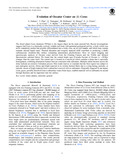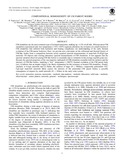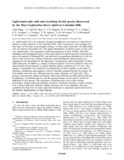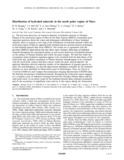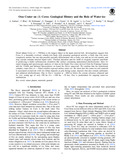Search
Now showing items 1-6 of 6
Evolution of Occator Crater on (1) Ceres
(The Astronomical Journal, 2017-02-17)
The dwarf planet Ceres (diameter 939 km) is the largest object in the main asteroid belt. Recent investigations suggest that Ceres is a thermally evolved, volatile-rich body with potential geological activity, a body which ...
Compositional homogeneity of CM parent bodies.
(The Astronomical Journal, 2016-08-10)
CM chondrites are the most common type of hydrated meteorites, making up ∼1.5% of all falls. Whereas most CM chondrites experienced only low-temperature (∼0°C–120°C) aqueous alteration, the existence of a small fraction ...
Light-toned salty soils and coexisting Si-rich species discovered by the Mars Exploration Rover Spirit in Columbia Hills
(Journal of Geophysical Research, 2008-12-19)
Light-toned soils were exposed, through serendipitous excavations by Spirit Rover wheels, at eight locations in the Columbia Hills. Their occurrences were grouped into four types on the basis of geomorphic settings. At ...
Distribution of hydrated minerals in the north polar region of Mars
(Journal of Geophysical Research, 2009-01-28)
The previous discovery of extensive deposits of hydrated minerals in Olympia Planum in the north polar region of Mars by the Mars Express OMEGA instrument raises important questions about the origin and subsequent ...
Temporal observations of bright soil exposures at Gusev crater, Mars
(Journal of Geophysical Research, 2011-01-27)
The Mars Exploration Rover Spirit has discovered bright soil deposits in its wheel tracks that previously have been confirmed to contain ferric sulfates and/or opaline silica. Repeated Pancam multispectral observations ...
Oxo Crater on (1) Ceres: Geological History and the Role of Water-ice
(The Astronomical Journal, 2017-08-04)
Dwarf planet Ceres (∅ ∼ 940 km) is the largest object in the main asteroid belt. Investigations suggest that Ceres is a thermally evolved, volatile-rich body with potential geological activity, a body that was never ...

